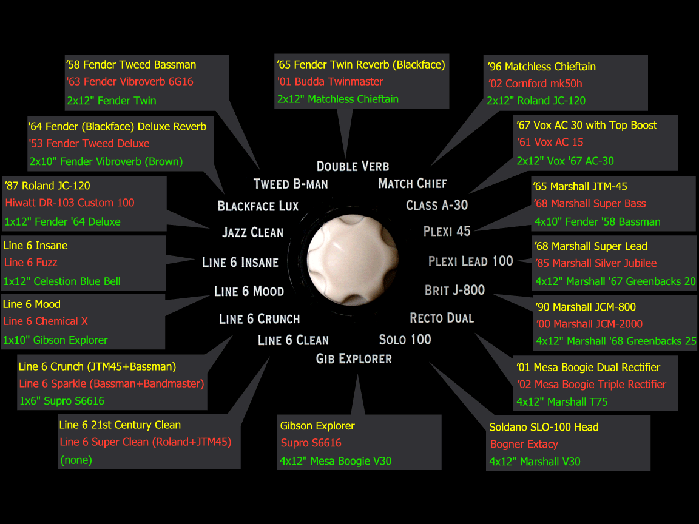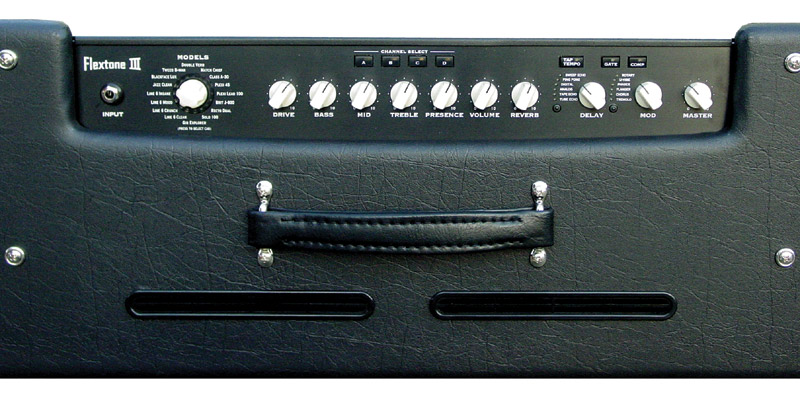Guitar Amplifier Design
| Line 23: | Line 23: | ||
[[Image:Flextone+III+XL-1.JPG]] | [[Image:Flextone+III+XL-1.JPG]] | ||
| − | |||
| + | This picture gives an overview of the control panel and shows all the controls described above. | ||
[[Image:Flextone-III-Refsheet-Colour.gif]] | [[Image:Flextone-III-Refsheet-Colour.gif]] | ||
Revision as of 02:52, 10 September 2008
Guitar Amplifier Design
For my design study I have decided to create a software version of the Line 6 Flextone III guitar amplifier. Although designing the modules that create the actual guitar tone is out of the scope of this project (any electrical/audio engineers around??) my design will model the core behaviour of this marvellous piece of equipment.
The Flextone III is a digital modelling amp which means that it uses digital methods to imitate a wide range of different amplifiers that are available on the market today. It's a jack of all trades!
Behavioural Overview
The amp allows you to choose from 16 different amp models with each model having a primary (yellow) mode and a secondary (red) mode. It also allows you to choose from 16 different speaker cabinet models but the speaker cabinet models do not have a secondary mode (their selection light is just green). The speaker cabinet selection allows you to choose what sort of speakers the currently selected amp model sounds like it's being played through.
The Flextone also has built in effects. There are two groups of effects and each group has 6 different options to choose from. The first group are all Delay (Echo) related effects, and the second group are all general effects such as: Chorus, Flanger, Tremelo, Phaser and so on. The delay group of effects has a variable knob called "Delay" that adjusts how noticeable the effect is when mixed with the original signal. The general group of effects also has a variable knob that does the same thing for those effects but it's called "Mod".
The last feature related to effects is the small "Tap Tempo" button located just above the group of delay effects. This button can be used to set the tempo of the delay effects. The user simply taps the button twice at a certain speed and the tempo is set. This tempo will apply to all 6 delay effects so it's not possible to have different tempos saved on the same channel. There are also 7 different variables that can be modified that affect the sound of your current settings (whatever they might be). These are: Drive, Bass, Mid, Treble, Presence, Volume and Reverb.
Lastly there are two switches that determine whether the sound-gate (kills unwanted background noise) is on or off and whether the compressor (makes all notes have roughly equal volume, great for solos) is on or off.
The Flextone has four different "channels" A, B, C and D that you can save a group of settings on. A group of settings consists of an amp model choice, a speaker cabinet choice, the 7 values of the D, B, M, T, P, V and R variables, the delay effect and general effect you might be using (if any) and the values of their "Delay" and "Mod" knobs respectively. Also included are is current set tempo for the delay effects and finally the status of the sound-gate and compressor (on or off). Once you have saved some settings to a Channel A for example, you can then click the Channel B button and the Flextone will load up the settings related to Channel B. Channel B's settings can be entirely different to Channel A's. You may decide you want to change something about the settings on Channel B so after you make that change you can just save the Channel B settings again.
There is one last feature of the amplifier to be mentioned and that is the Master Volume control. While modifying the Volume variables on each different Channel will set the volumes of each Channel in relation to each other, the Master Volume adjusts the volume of the entire amplifier. This means the volumes of each channel are proportionally adjusted up or down by the master but always have the same relative difference in volume.
A quick example: A has it's volume set to 10. B, C and D have their volumes set to 5. The master volume level is currently 2. This means A's volume level is 2 (based on the measurement of the master volume) and the other three channels have a master volume value of 1. If the master if turned up to 3, then A has a volume of 3 and the other channels have a volume of 1.5.
This picture gives an overview of the control panel and shows all the controls described above.
 This picture shows the amp/cabinet selection tool. Yellow and Red names are the primary and secondary modes of each amp and the Green names are the names of the speaker cabinets.
This picture shows the amp/cabinet selection tool. Yellow and Red names are the primary and secondary modes of each amp and the Green names are the names of the speaker cabinets.
